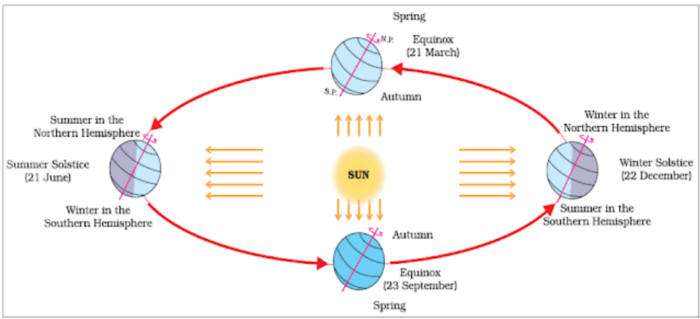Summer Solstice and Winter Solstice are used to describe the shortest and longest days of the summer and winter seasons.
The summer solstice occurs when one of the Earth’s poles (North pole) has its maximum tilt toward the Sun.
The winter solstice or hibernal solstice occurs when one of the Earth’s poles (North Pole) has its maximum tilt away from the Sun.
This article will further elaborate upon the differences between Summer and Winter Solstice within the context of the IAS Exam.
Check all the important differences between articles from wide-ranging topics concerning the UPSC exam in the linked article.

(Image source: Class 6 NCERT)
The following table will highlight the differences between summer and winter solstice
Difference Between Summer Solstice and Winter Solstice
|
Summer Solstice |
Winter Solstice |
| Summer solstice occurs when the North Pole is tilted closest to the Sun | Winter solstice occurs when the North Pole is tilted farthest from the sun |
| It occurs on 21st June | It occurs on 22nd December |
| The summer solstice brings the longest day in the Northern Hemisphere, as it is tilted towards the sun. | Winter solstice brings the longest night in the Northern Hemisphere as it is tilted away from the sun |
| Southern Hemisphere has the shortest night | Southern Hemisphere has the longest days |
| Sun rays directly fall over Tropic of Cancer | Sun rays directly fall over Tropic of Capricorn |
| The places beyond the Arctic circle experience continuous daylight for about six months | The places beyond the Antarctic circle experience continuous daylight for about six months |
| As a large portion of the Northern Hemisphere receives sunlight and heat during the summer solstice, it summers in Northern Hemisphere; whereas winters in Southern Hemisphere | As a large portion of the Southern Hemisphere receives sunlight and heat during the winter solstice, it is summer in Southern Hemisphere, whereas summers in Northern Hemisphere |
| Although the summer solstice is the longest day of the year for the Northern Hemisphere, the dates of the earliest sunrise and latest sunset vary by a few days.
This is because the Earth orbits the Sun in an ellipse, and its orbital speed varies slightly during the year |
Although the winter solstice itself lasts only a moment, the term sometimes refers to the day on which it occurs. |
| Although the Sun appears at its highest altitude from the viewpoint of an observer in outer space or a terrestrial observer outside tropical latitudes, the highest altitude occurs on a different day for certain locations in the tropics. | Traditionally, in many temperate regions, the winter solstice is seen as the middle of winter, but today in some countries and calendars, it is seen as the beginning of winter. |
Some important Geography-related differences between articles are linked below:
Difference Between Advancing and Retreating MonsoonDifference Between Western and Eastern GhatsDifference Between Summer and Winter Equinox:-
Download PDF HereAspirants can find complete information about upcoming Government Exams through the linked article. More exam-related preparation materials will be found through the links given below:
Related Links
Comments